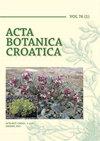东南欧城市动植物研究分析
IF 0.7
4区 生物学
Q3 PLANT SCIENCES
引用次数: 4
摘要
在过去的二十年里,专注于欧洲城市生态系统的研究文章数量显著增加。然而,调查的城市分布非常不均衡,大多数研究都集中在中欧。本分析的目的是对先前对东南欧城市植物区系和植被的研究结果提供现实的见解。该分析共涉及149篇文章,根据研究的主题和概念进行分类。东南欧各国对城市植物群和植被的探索率差异很大。植物区系方法是最常见的。尽管东南欧的一些国家有大量的植物区系研究(例如塞尔维亚和克罗地亚各有20多个),但与其他欧洲地区相比,其城市植物区系的探索仍然不足。此外,使用不同的方法使得无法以适当的方式比较结果并得出相关结论。与欧洲大部分地区的研究不同,欧洲东南部的研究具有更广泛的空间框架和统一的方法,它们通常指的是个别城市、特定栖息地或城市的某些部分。因此,将东南欧纳入大规模研究将是有益的。本文章由计算机程序翻译,如有差异,请以英文原文为准。
An analysis of research into urban flora and vegetation in Southeast Europe
In the last two decades, the number of research articles focused on urban ecosystems in Europe has increased significantly. However, the cities investigated are very unevenly distributed, and most of the studies are focused on Central Europe. The aim of this analysis was to provide a realistic insight into the results of previous research into the urban flora and vegetation of Southeast Europe. The analysis covers a
total of 149 articles, classified according to the topic and concept of
research. The rates of exploration of urban flora and vegetation vary considerably across the countries of Southeast Europe. The floristic approach was the most common. Although some countries of Southeast Europe have a significant number of floristic studies (e.g. Serbia and Croatia with more than 20 each), their urban flora is still insufficiently explored compared to other European regions. Also, the use of different methodologies makes it impossible to compare results in
an adequate way and draw relevant conclusions. Unlike the studies in most of Europe, with a broader spatial framework and uniform methodology, in Southeast Europe they usually referred to individual cities, specific habitats or certain parts of the cities. Hence, including Southeast Europe in large-scale studies would be beneficial.
求助全文
通过发布文献求助,成功后即可免费获取论文全文。
去求助
来源期刊

Acta Botanica Croatica
PLANT SCIENCES-
CiteScore
2.50
自引率
0.00%
发文量
34
审稿时长
>12 weeks
期刊介绍:
The interest of the journal is field (terrestrial and aquatic) and experimental botany (including microorganisms, plant viruses, bacteria, unicellular algae), from subcellular level to ecosystems. The attention of the Journal is aimed to the research of karstic areas of the southern Europe, karstic waters and the Adriatic Sea (Mediterranean).
 求助内容:
求助内容: 应助结果提醒方式:
应助结果提醒方式:


